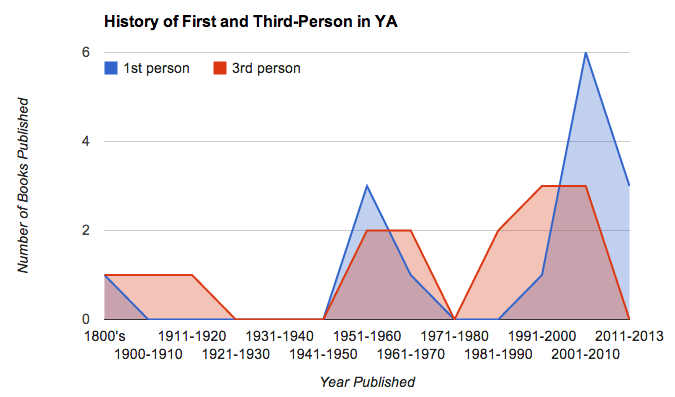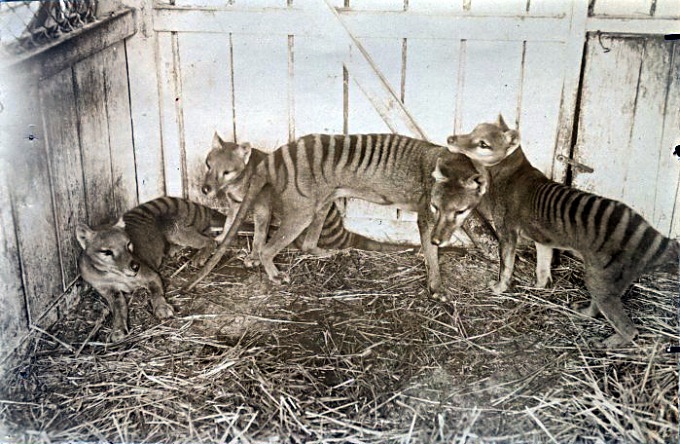You may have noticed that many popular YA titles today are written in the first-person narrative. But why? Why is first-person so popular with the YA audience?
In her blog, YA writer and children’s book illustrator Ingrid Sunberg shares five reasons why authors choose to write in the first-person. Ingrid observes that first-person gives the reader a quick connection with the protagonist, makes the story believable, helps develop the protagonist, is somewhat easy to write, and creates an agreement with the reader of how the story will be told.
To help find the answer to why readers connect with first-person narratives, I decided to make a graph, because graphs are my jam.
First, I took thirty titles of popular YA fiction all the way from the mid 1800’s to 2013. These titles are or have been enormously popular, and a couple of titles are just a few of my favorite YA and Middle Grade books. Next, I went through and marked which stories are told in first-person and and which were told in third-person (limited, objective, and omniscient).
|
1st Person |
Year Published |
|
|
3rd person |
Year Published |
| 1 |
The Adventures of Huckleberry Finn |
1884 |
|
1 |
Little Women |
1868 |
| 2 |
The Catcher in the Rye |
1951 |
|
2 |
Anne of Green Gables |
1908 |
| 3 |
To Kill a Mockingbird |
1960 |
|
3 |
The Secret Garden |
1911 |
| 4 |
Island of the Blue Dolphins |
1960 |
|
4 |
Charlotte’s Web |
1952 |
| 5 |
Are You There, God? It’s Me, Margaret |
1970 |
|
5 |
Lord of the Flies |
1954 |
| 6 |
The Perks of Being a Wallflower |
1999 |
|
6 |
The Phantom Tollbooth |
1961 |
| 7 |
The Sisterhood of the Traveling Pants |
2001 |
|
7 |
A Wrinkle in Time |
1962 |
| 8 |
Twilight |
2005 |
|
8 |
Hatchet |
1987 |
| 9 |
The Book Thief |
2005 |
|
9 |
Number the Stars |
1989 |
| 10 |
The Lightning Thief |
2005 |
|
10 |
The Giver |
1993 |
| 11 |
The Host |
2008 |
|
11 |
Ender’s Game |
1994 |
| 12 |
The Hunger Games |
2008 |
|
12 |
Holes |
1998 |
| 13 |
Divergent |
2011 |
|
13 |
Eragon |
2002 |
| 14 |
Incarnate |
2012 |
|
14 |
Harry Potter and the Sorcerer’s Stone |
2003 |
| 15 |
Vampire Academy |
2013 |
|
15 |
Inkheart |
2005 |
The information I gathered already surprised me. I assumed that of the thirty books, at least 66% would be written in first-person. But of the thirty books I chose, exactly half were written in third-person.
Next, I charted how many books from both POV’s were published in ten year increments from 1800 – 2013.

You may or may not be surprised by my microcosmic, pedestrian research. What surprised me was that technically, third-person isn’t any less popular as a whole. In fact, according to my chart, it’s been steadily increasing in popularity through the years. Note that while I only took the first books in popular series, keep in mind how popular all of the Harry Potter books were (third-person), with the last book published in 2007. Third-person YA stories aren’t going anywhere. They’re steadily increasing in popularity, according to my small-scale study.
First-person narrative YA and Middle Grade novels increase sharply in popularity according to my chart, especially in the late 1990’s and early 2000’s. First-person narrative is trendy, but it has also steadily grown in popularity as well.
But why has the first-person narrative become so popular recently in YA and Middle Grade fiction?
This brings us to my theory: chicks and their diaries, man.
Chicks, man.
In this article from The Guardian, Vanessa Thorpe summarizes a 2009 study in which researchers interviewed 2,000 people about their reading habits. Researchers found of the women interviewed, forty-eight percent could be considered avid readers, while only twenty-six percent of men could be considered the same. Thirty-two percent of men admitted to only reading two books per year, while eighteen percent of the women interviewed said the same. According to this article on NPR, surveys conducted in the U.S., Canada, and Britain concluded that men account for only twenty percent of readers in the fiction market.
While it could be argued that maybe many of the study’s participants were adults and did not read YA fiction, an article in Publisher’s Weekly claims otherwise:
“More than half the consumers of books classified for young adults aren’t all that young. According to a new study, fully 55% of buyers of works that publishers designate for kids aged 12 to 17 — known as YA books — are 18 or older, with the largest segment aged 30 to 44, a group that alone accounted for 28% of YA sales. And adults aren’t just purchasing for others — when asked about the intended recipient, they report that 78% of the time they are purchasing books for their own reading. The insights are courtesy of Understanding the Children’s Book Consumer in the Digital Age, an ongoing biannual study from Bowker Market Research that explores the changing nature of publishing for kids.”
From this evidence, we can conclude that women read more fiction novels than men by a wide margin, and that plenty of those women are reading YA.
Diaries: The Missing Link to First-Person
For as long as I remember, I’ve kept journals. I have an entire bookshelf dedicated to my journals, one dating back to fifth grade. According to this January 2013 article by Carolyn Gregoire, I’m not the only one. According to a study, eighty-three percent of girls aged 16-19 write about their lives in a journal.
Let’s examine common characteristics of the female diary entry.
Disclaimer: these characteristics may or may not match your own diaries. These are typical characteristics I’ve noticed from the diaries I’ve snuck into (Okay, only once, and I feel awful about it. The saving grace was that the entry I flipped to talked about wanting mango ice cream instead of vanilla, and then I stopped reading immediately), have heard fellow females talk about, or have read as published works.
- Almost always (I can’t imagine otherwise, frankly) written in first-person.
- Focus on emotional reaction to situations and events.
- Chronicles important events.
- Marks events that have just happened.
- Divulge true feelings and secrets.
- Examine secret longings.
- Heavy on self-evaluation.
- Usually written in a stream of consciousness fashion.
- Has voicing specific to the person writing the journal
Now, let’s compare those characteristics to a YA first-person story with a female protagonist:
- Focused on one central character who tells the story
- Emotionally charged
- Has voicing specific to the protagonist
- Tells important events through the protagonist’s point of view
- Lets the reader peek into the mind of the protagonist, viewing her longings, desires, and emotional reactions
- Usually follows as steady span of time without skipping through time.
Seeing the strong connection between the two? Now think about the target for most YA fiction. Research shows that most avid readers are women. Research also shows that many young women journal. When you combine the two facts, it makes a compelling case.
My theory is this: girls aged 12-18 who read regularly can and do connect quickly with a first-person narrative because it is reminiscent of their own journaling behavior. That is to say, how young girls process important events in their lives through journaling is very similar to a protagonist’s process of self-evaluation and self-discovery in a YA first-person narrative.
When a young girl picks up a YA first-person story, she is looking into the mind of the protagonist, almost the same as reading that protagonist’s own diary. As the young girl grows into a woman, whether or not she decides to continue journaling, she will understand the connection of first-person narrative because she has already written it.
Third-person in YA is in no way dying, but it may not have the strength of connecting so immediately with its audience as YA first-person storytelling does.
What do you think about the connection of girls who journal and girls who read first-person YA novels? I would love to know if you agree or disagree! Please let me know what you think in the comments.
 Boy, do I have a book for you! You’ve probably never heard of it, but it’s spectacular. It’s called The Shining by Stephen King.
Boy, do I have a book for you! You’ve probably never heard of it, but it’s spectacular. It’s called The Shining by Stephen King.

